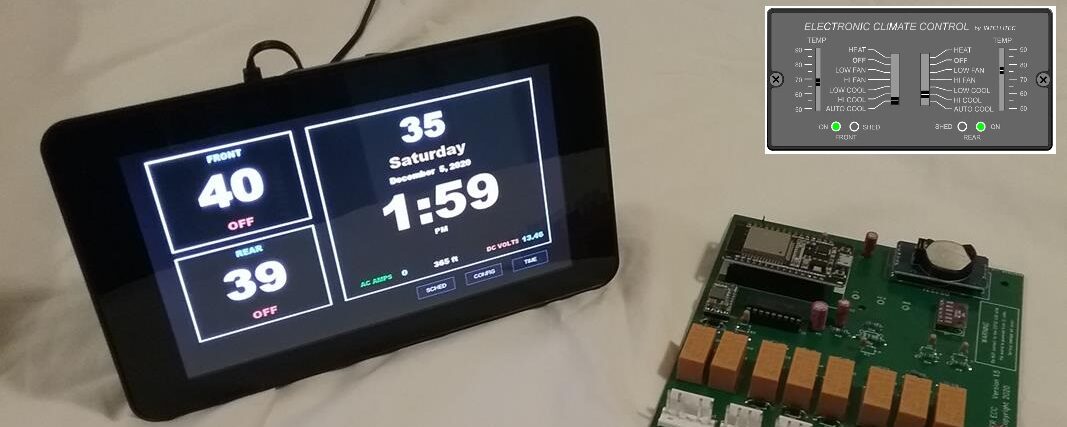WAITER ECC - OPERATION
There are two “DIM” settings, one for DAY and one for NIGHT. After about 30 seconds of no touch on the screen, the screen will dim to either of these two settings. Normally, when the screen is touched, it goes to full brightness, As of version 4.7.2, a “NIGHT BRIGHT” level setting was added, If its night time, instead of going to full brightness, the screen will go to the NIGHT BRIGHT level.
There are two select-able ways of determining DAY and NITE: Sunrise/sunset (AUTO) or by a schedule (Specific time).
Sunrise/Sunset: When AUTO is selected, it uses the date being reported by the real time clock to compute estimated sunrise / sunset times for that date. For example, If the date is Feb 15th, the sunrise (SR) will be approximately 7:30 am and sundown (SD) will be approximately 6:07 pm. It then uses the current time to determine if it should dim DAY or NIGHT. If the time is between 15 minutes before SR and 60 minutes after SD , it uses the DAY dim setting. Otherwise it uses the NIGHT dim setting.
Schedule: – Specific Time: This is generally the more popular way. Specific times are set for DAY and NITE.
DIM setting ranges from 5 to 100. These are not linear, i.e. 10 isn’t twice as bright as 5. Also, every display responds differently to this setting. A dark room night DIM setting on one display may be 6, but on another display it may be 14. Change the setting by clicking on it, It increments up to “100”, then the next increment step will be “5”. Click SAVE to save your settings.
Waiters ECC method for A/C AUTO function behaves a little differently than the Intellitecs method.
In A/C AUTO, the A/C blower speed is automatically changed as the temperature changes. The normal blower speed is LO. The blower will switch to HI if the temperature is 4 degrees or more above the set point. When the temperature drops more than 1 degree below the set point, the compressor turns off, then about 30 seconds later, the blower will shut off.
When the temperature goes above the set point, the blower turns on LO, then after a 15 second delay, the compressor will start, if there is no SHEDing.
Most motorhomes that use these early model Intellitec ECC system have a shore power capacity of 30 amps. SHEDing is a way of preventing electrical loads inside the motorhome from exceeding 30 amps and tripping circuit breakers.
SHED is when the ECC detects a possible overload and shuts down one of the compressors to reduce the load. It SHEDs the load. The ECC monitors the 30 amp circuit, when it starts an A/C unit and compressor, if it sees that the current is exceeding about 28 amps, it’ll shut the compressor off again, this is called SHEDing.
How Waiter ECC performs SHEDing:
Before commanding a compressor to start, Waiters ECC does what we call a Pre-SHED check to determine if starting the compressor might cause an overload. If it appears like it would, then starting is delayed until the amps being drawn is reduced enough to allow the compressor to be started.
If the compressor is started, if the amps exceed about 28 at any time, the compressor is shut off, SHEDed. When this happens, the compressor cannot be restarted until a hard start delay (2 minutes) has elapsed. This “hard start delay” allows the head pressure in the compressor to bleed down, making it easier to start the compressor..
What is Pre-SHED? – In the CONFIG screen, the approximate BTU ratings of each A/C unit is selected. Waiters ECC uses this to estimate how much current the compressor will draw when its started. Before starting the compressor, it adds the estimated amps to the amps the motor-home is currently drawing, if this exceeds about 28 amps, the compressor will not be started.
SHED is displayed on the operators touch screen as a red square in the upper right corner of the small window.
Pre-SHED is displayed as an alternating rec/green square.
The Waiter ECC utilizes its own Real Time Clock (RTC) module to keep track of time. Most installations are mobile, crossing time zones, passing in-to and out-of time zones, daylight savings times, etc. Since we can’t depend on an internet connection or other convenient way to account for the vast number of possibilities, we decided to leave it up to the operator to set the correct date/time.
The RTC module is located on the controller circuit card and reports current time to the MQTT server once a minute. The RTC has a battery backup so it keeps time even when no power is applied. The battery is good for 5-6 years and is easy to replace.
This little box is a convenient reminder that you have a schedule running for either the FRONT or REAR system.
When you have a schedule (click on the SCHED tab) activated and running, the little gray square will illuminate in the lower left corner of the FRONT and/or REAR temperature displays.
This feature was introduced as of version 4.3.0. When selected, it controls both the furnace and the A/C unit at the same time. The HEAT and A/C set points are set individually by using the regular HEAT and A/C modes. The set points must be at least 5 degrees apart in order to select the HEAT – A/C mode. Once selected, the furnace kicks on if the temperature drops below the HEAT set point, and the A/C unit kicks on if the temperature goes above the A/C set point. The A/C unit operates exactly the same as if it was in A/C AUTO mode, the blower changes speed automatically and turns off about 30 seconds after the compressor kicks off.
You can change both set points at the same time by using the UP and DOWN buttons.
